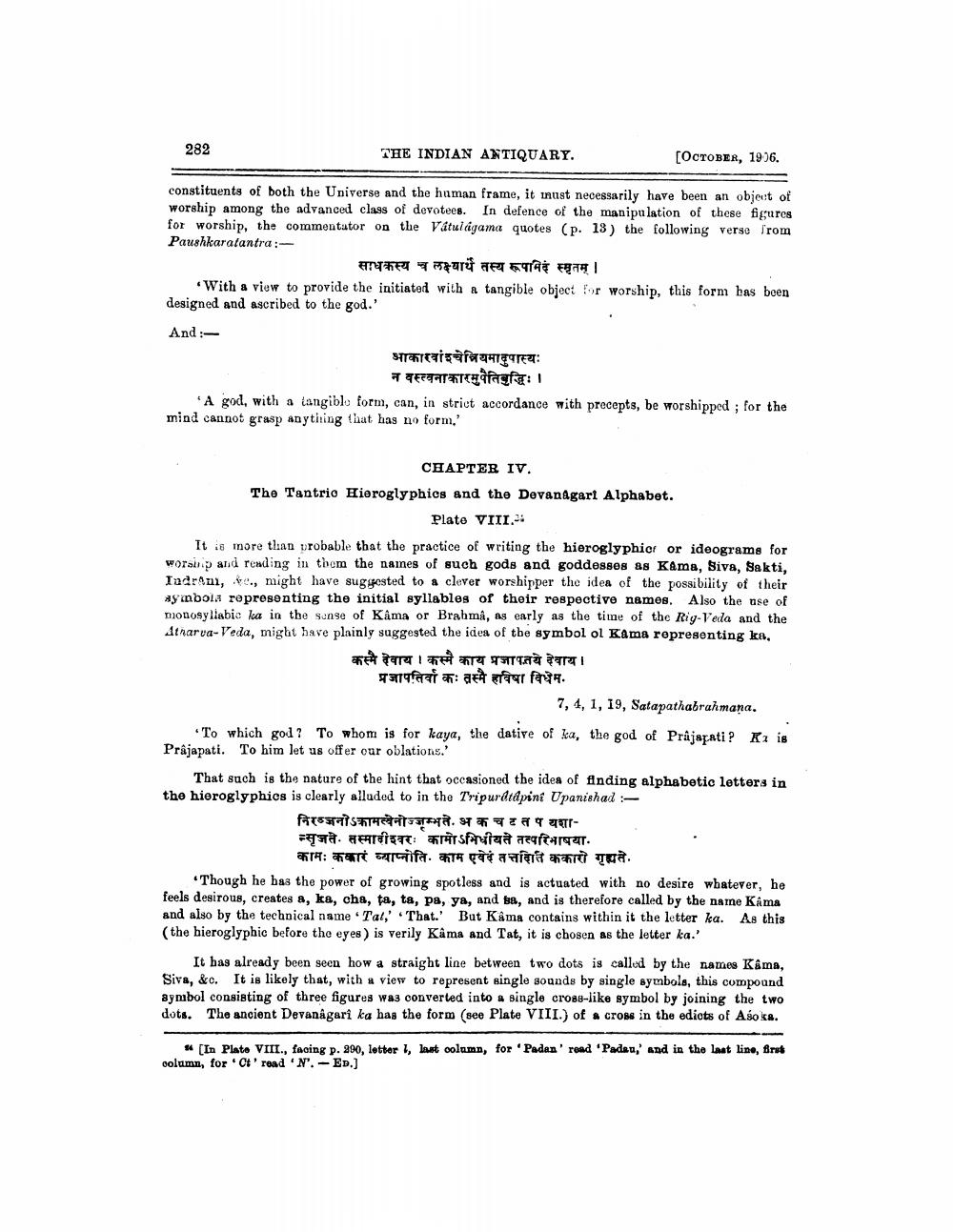________________
282
THE INDIAN ANTIQUARY.
[OCTOBER, 1996.
constituents of both the Universe and the human frame, it inust necessarily have been an object of worship among the advanced class of devotees. In defence of the manipulation of these figures for worship, the commentator on the Vatuiagama quotes (p. 13) the following verse from Paushkaratantra:
साधकस्य च लक्ष्यार्थ तस्य रूपमिदं स्मृतम् | With a view to provide the initiated with a tangible object for worship, this form has been designed and ascribed to the god.'
And:
आकारवांश्चेनियमानुपास्यः
न वस्त्वनाकारमुपैतिबुद्धिः। A god, with a tangible form, can, in strict accordance with precepts, be worshipped ; for the mind cannot grasp anytiring that has no form,
CHAPTER IV. The Tantrio Hieroglyphics and the Devanagart Alphabet.
Plate VIIIIt is more than probable that the practice of writing the hieroglyphic or ideograms for worship and reading in them the names of such gods and goddesses &s Kama, Siva, Sakti, Tadraai, C., might have suggested to a clever worshipper the idea of the possibility of their Ayinbola representing the initial syllables of their respective names. Also the use of monosyllabic ka in the sense of Kama or Brahma, as early as the time of the Rig Veda and the Atharva-Veda, might have plainly suggested the idea of the symbol ol Kama ropresenting ka,
कस्मै देवाय । कस्मै काय प्रजापतये देवाय । प्रजापतिर्वा कः तस्मै हविषा विधेम.
7, 4, 1, 19, Satapathabrahmana. • To which god? To whom is for kaya, the dative of ka, the god of Prajapati? K is Prajapati. To him let us offer our oblations.'
That such is the nature of the hint that occasioned the idea of Anding alphabetic letters in the hieroglyphios is clearly alluded to in the Tripurdiapini Upanishad -
निरठजनोऽकामत्वेनोज्जम्भते. अ क च ट त प यशा
सृजते. तस्मातीश्वरः कामोऽभिधीयते तत्परिभाषया.
कामः ककारं व्याप्नोति. काम एवंदं तत्तदिति ककारी गृह्यते. Though he has the power of growing spotless and is actuated with no desire whatever, he feels desirous, creates a, ka, cha, ta, ta, pa, ya, and ba, and is therefore called by the name Kama and also by the technical name.Tal,' That.' But Kâma contains within it the letter ka. As this (the hieroglyphic before the eyes) is verily Kama and Tat, it is chosen as the letter ka.
It has already been seen how a straight line between two dots is called by the names Káma, Siva, &c. It is likely that, with a view to represent single sounds by single symbols, this compound symbol consisting of three figures was converted into a single cross-like symbol by joining the two dots. The ancient Devanagari ka has the form (see Plate VIII.) of a cross in the edicts of Asoka.
* (In Plate VIII., facing p. 290, letter 1, laat oolamn, for 'Padan read 'Padan,' and in the last line, Brat column, for Ct' read 'N'.-ED.)




